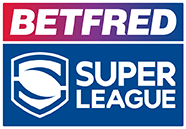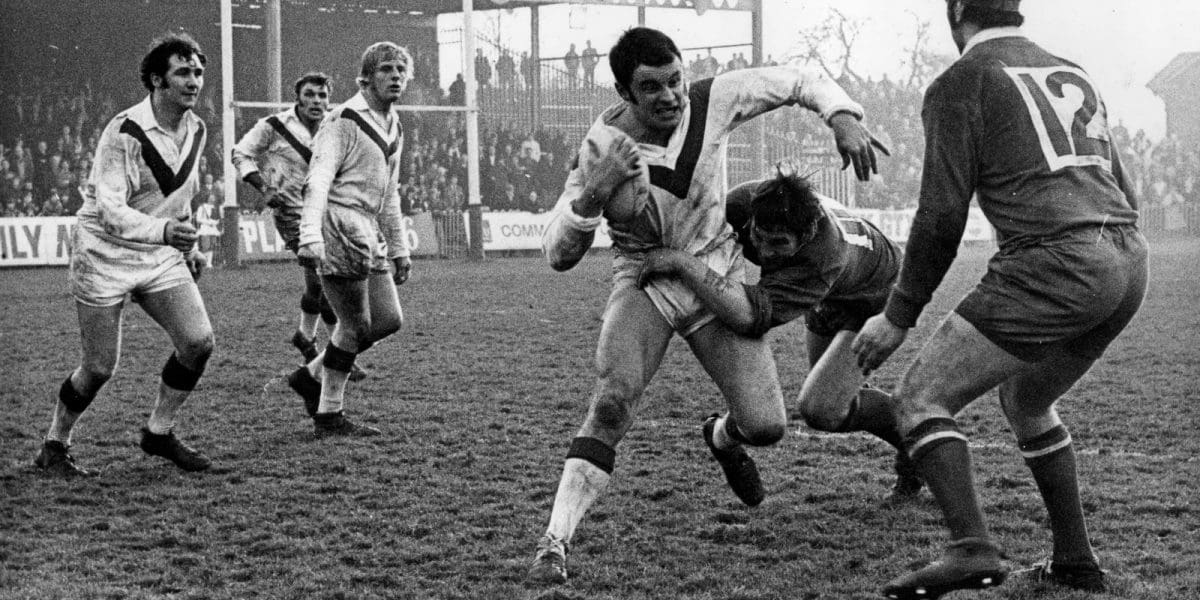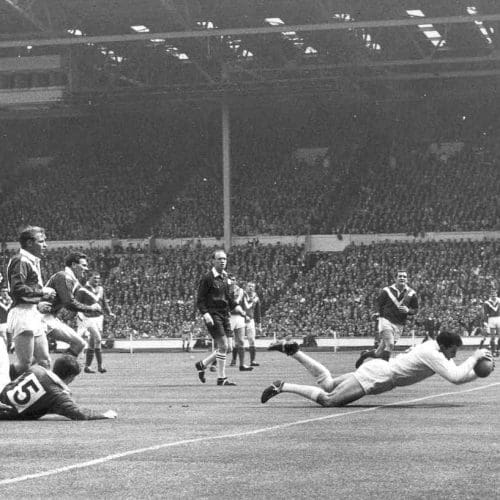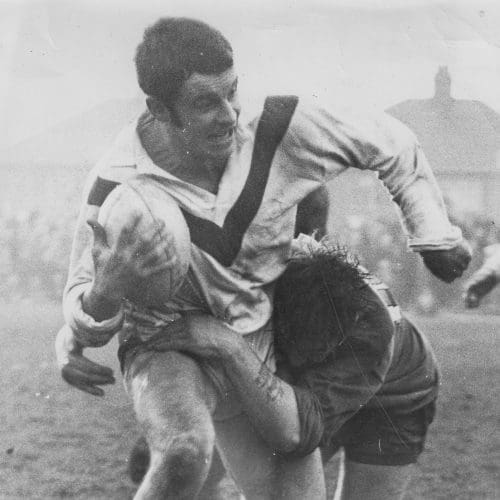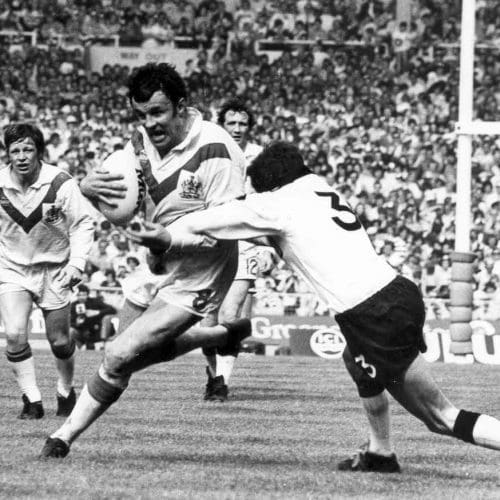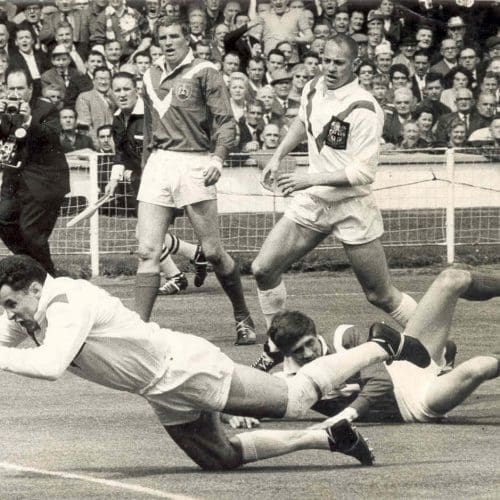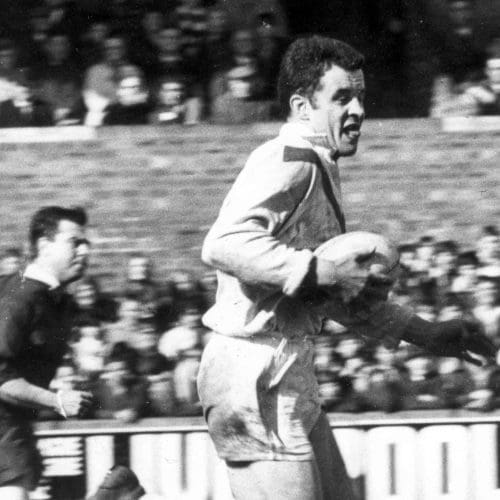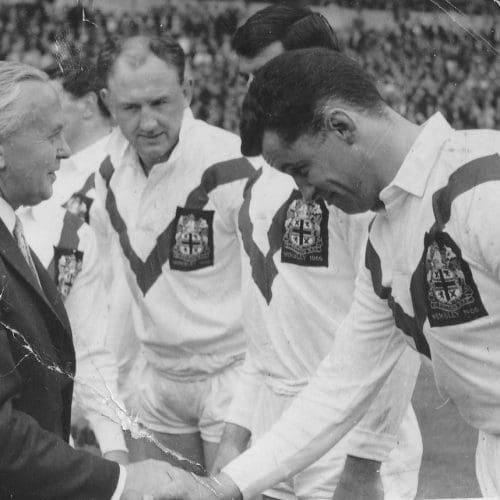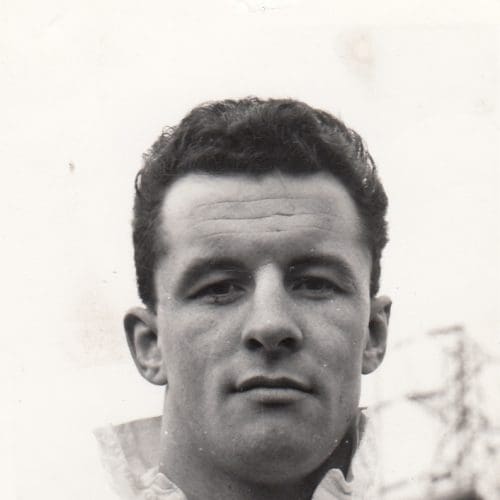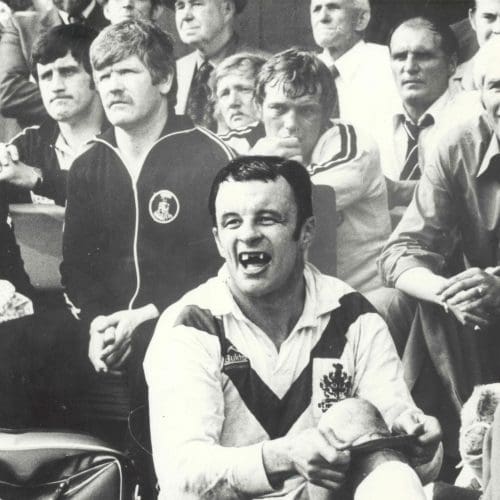The St Helens club and, indeed, the rugby league world, have been saddened by the passing of John Mantle, at the age of 76, after a long illness.
He was one of Saints’ greatest-ever signings from the Welsh valleys, a superb forward, who married a local girl, Lorraine, in 1966, and remained a resident of the St. Helens area all his life, becoming a well-respected teacher and an ever-popular member of our community.
Born in Cardiff, South Wales, on March 13 1942, he was a real all-round sportsman in his youth. An Under 19s national triple jump champion, John played international soccer for Welsh Boys Clubs and was his school’s cricket captain before going to Loughborough College. He became shot-putt champion and captain of the rugby team, playing for British Universities, Leicester and Newport, where he was a team-mate of fly-half David Watkins and his future team-mate at Saints, scrum-half Bob Prosser.
Yet John was nearly lost to rugby altogether. As a centre half, he was a target for Wolverhampton Wanderers, who were still a powerful club in English football. “I played six trial games for them,” he recalled recently. “I then had a chat with the manager, Stan Cullis, who said he wanted to sign me but he told me that being a soccer player was a somewhat precarious occupation.
“I decided to go to college and get my teaching qualifications, although I could still have gone back to Wolves when I had finished at Loughborough, but it was not to be.”
Given his all-round athleticism, there is little doubt he would have been a success.
Essentially a number 8 forward in the 15-a-side code, he represented Wales on eight occasions, including the 1964 tour to South Africa. Despite losing to the Springboks 24-3 in Durban, John had been the most outstanding Welsh player. Rugby League clubs were taking note, with Saints showing particular interest.
“I can remember talking to one of the Directors at the time who wanted to know more about John Mantle and would he be good enough for St. Helens,” recalls Peter Harvey, who had himself recently signed from rugby union. “John and I had played in the Loughborough First XV, so I knew exactly what he was capable of. I told him that they would be signing one of the fastest forwards the club had ever seen!”
Yet John knew all about the town of St. Helens, as he explained in his testimonial brochure some years later: “In all honesty, the decision was made easy by the fact that I had spent some time in St. Helens during my college years – I had become friendly with a St. Helens lad [Roy Woods] whilst at college and we had talked a lot about the league game.”
At over six foot and fifteen stones, he was seen as the ideal replacement for the legendary running second-rower Dick Huddart, who had joined St. George in Sydney in 1964. Mantle signed for the Knowsley Road club on January 1 1965, making his debut three weeks later at home to Whitehaven in a 16-3 victory.
John made rapid progress, developing into one of the greatest all-round second row forwards in rugby league.
“Wales lost a great player when Mantle turned professional and League gained a gem of a forward,” wrote Robert Gate in his book Gone North. “Union forwards usually take a considerable time to adapt to League techniques and many simply do not make the grade despite impressive amateur pedigrees. John Mantle took to the game like a duck to water for unlike many Union packmen he was not a specialist.”
He was a big strong lad, with tremendous stamina, who could devastate defences with his powerful long-striding surges. “He didn’t need to be taught the art of tackling,” adds Robert Gate. “There are precious few places to hide in top class rugby league and John Mantle was always to be found out there in the open.”
John could look after himself – and his team-mates – when the going got tough, making him ideal for Test Match football – especially against the Australians, who were more than aware of his devastating potential with the ball.
He was an integral member of the Saints’ side that won four trophies – Lancashire League, League Leader’s Bowl, Challenge Cup and League Championship – in 1965-66, when he showed terrific stamina, playing in no less than 48 matches during the campaign, relishing the emphasis on fitness that Coach Joe Coan had brought to the club.
Playing at loose forward, John displayed his power by crashing over for Saints’ first try in the Challenge Cup Final at Wembley, against deadly rivals Wigan, the result of a clever switch move involving Peter Harvey and Tom Van Vollenhoven. “He had great lines of running – straight and into the gaps,” remembers Peter Harvey. “And that try was straight from the training ground.”
On January 16 1966, he made his Great Britain debut against France in Perpignan and at the end of the Four Cups campaign he was an automatic choice for the Australasian Tour, together with his team-mates Tommy Bishop and Cliff Watson.
John played his first Ashes Test at Sydney on June 25, when Great Britain pulled off a fine 17-13 victory, although they later lost the rubber in the Third Test at the Sydney Cricket Ground by just five points. John had another crack at the Aussies during their 1967 tour, playing in the notorious 16-11 victory at Headingley and at the White City, where Australia set the platform for retaining the Ashes in a 17-11 success.
John decided not to go on the Lions’ tour in 1970, for personal reasons and made his thirteenth and final appearance for Great Britain at Headingley, in the Second Test against Australia on November 24 1973 when the Kangaroos won 14-6. It was a pity that the start of Mantle’s international career coincided with Britain’s decline as a major force, reflected in the dominance of the Australians – something that has continued to the present day!
John captained the re-formed Welsh team to victory against England at Salford in 1969, one of six St. Helens players, including Frank Wilson, Graham Rees, John Warlow, Kel Coslett and Bob Wanbon, in the side. John played 16 times for Wales overall during his rugby league career, captaining them on three occasions. He played his last game against England at Knowsley Road on May 28 1978, when the Welsh were heavily defeated to the tune of 13-60. The English full-back that day was his former Saints’ team-mate and another good friend, Geoff Pimblett.
By the early 1970s, John had won every honour in the game at club level. Despite showing the scars of battle, including the amputation of the middle finger from his left hand, he was still a major influence in the club’s Championship-winning sides of 1970 and 1971. Yet it was at Wembley in two Challenge Cup Finals that he is best remembered. John played in the 1972 Final against Leeds with twelve stitches in his head, as a result of a car crash, but it did not stop him playing a major role in the second row during the Saints’ 16-13 success. “I requested to the doctor not to put 13 in, for obvious reasons,” he recalled. “I decided to play wearing protective headgear. Fortunately, it was a gamble that paid off.”
By 1976, he had graduated to the front row in the famous ‘Dad’s Army’ team that defeated Widnes. His grin of self-satisfaction on the bench after being replaced in the final few minutes is one of the most enduring images in Saints’ history!
John, together fellow Welshman Kel Coslett, went on to play their last game for the club on British soil in the brilliant 15-2 Premiership Final victory against Salford – a fitting end to their careers at Knowsley Road. They then went on the club’s Australasian tour where they played against Eastern Suburbs in the first ‘World Club Challenge’ match.
Overall, John had appeared in an incredible 19 major finals, with Coslett just one behind! This included the club’s one-and-only First Division Championship [1974-75], three Championship final victories [1966, 1970 and 1971] and three Challenge Cup final successes [1966, 1972 and 1976]. He played 435 matches for the Saints, scoring 69 tries and also kicked two goals, for a total of 208 points – a proud record indeed.
John also enjoyed a successful Testimonial in the mid-1970s and was subsequently inducted into the St. Helens Player’s Association Hall of Fame. “John was a good friend of mine,” says fellow Welshman Kel Coslett. “He was a good fellow and a tremendous player with great ability. John would always listen to advice and was a good team man. Put it this way – he would always be in my team.” Enough said!
Always an extremely durable character, as we have seen, John went on to play more games than any other forward to come out of Wales. His last match was on March 31 1982, when he scored a try for Blackpool Borough against Bramley. His post-Saints career had also taken him to Salford, Leigh, Barrow, Keighley, Oldham and the Cardiff Blue Dragons, where he met up once again with David Watkins.
John first taught Physical Education at Grange Park School when he graduated from Loughborough and later enjoyed a similar role at Rivington Road, where the likes of future Saints’ great Neil Holding came under his tutelage. He also taught at Selwyn Jones high School and Briar’s Hey School in Rainhill. John also enjoyed pastoral roles as a mentor for youngsters and loved taking school teams for football, cricket and rugby.
Daughter Janine tells of her father’s caring and compassionate side, unlike his uncompromising demeanour on the rugby field. “He will always be our hero,” she adds. “He was such a big family man and above all, a real gentleman.” Amen to that.
Saints Chairman Eamonn McManus shared the grief of Saints fans far and wide, penning this tribute:
“It’s with great sadness that we hear of the passing of an all-time great Saint, John Mantle.
“He was from that era of magnificent players who moulded St Helens into the world famous rugby league club that it is today.
“He moved from Welsh rugby union, laid down his family roots in St Helens, and became a great player in one of our greatest ever sides.
“It’s an abiding boyhood memory of mine watching him perform with such distinction for St Helens and for Great Britain. It was an equal pleasure, in later years, to get to know the absolute gentleman that he was. He will be greatly missed, but also fondly remembered, by all.”
Everyone at the St Helens club sends their condolences to John’s wife, Lorraine, son Kelvin, daughter Janine and grandchildren Ryan and Rhys at this sad time.
The funeral will take place on Friday November 30 2018 at St Luke’s Church on Knowsley Road from 10:30am before moving to St Helens Crematorium.
The family are asking people to wear something bright to help them celebrate John’s life.
There are also requesting close family flowers only and if you want to make a donation then you can do so via the family, and they will be passed to the Alzheimers Society.
John Mantle, Born March 13 1942 – Died November 18 2018.
Written by Alex Service.

